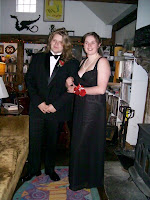
A Coward’s Guide to Beekeeping
Some people jump out of planes for excitement, some climb Annapurna. My foray into nerves, high blood pressure and profuse sweating is the gentle art of beekeeping. Usually I dislike the things I fear, but I adore my bees. Nevertheless, it took an enormous surge of willpower to get suited up to visit the bees and make sure last week’s hiving went well.
The idea, as you may recall, is to get the bees out of their package and into the hive, where they fly around getting used to the queen, who dangles in her own cage, nibbling at the candy plug, as the bees outside eat their way in. Presumably, all this eating and smelling her pheromone make for love, and when the plug is consumed, she is welcomed into the hive to lay eggs and found a dynasty.
Things can go wrong, however. If you come back a minute before a week has passed, the hive is likely to blame the disturbance not on you, the nosy giant, but on the new queen, and when she peeks out of her cage, kill her.
Yesterday would have been the day to visit, but I “forgot”, being so taken up with gardening. Today was just as sunny, with less wind, an ideal day to open the hive and see what’s been going on.
With some reluctance, I suited up. Some beekeepers saunter into their bee yards wearing shorts and t shirts. I didn’t have a suit for the first year, and that made me nervous and neglectful. I’d lift the top of the hive, see a writhing mass of bees, say a quick hello, close ‘em up again and sprint home. Needless to say, I didn’t have the faintest idea of what was actually happening in the hive-- was the queen laying properly? Were there queen cells (a sign of an impending swarm)? Were the bees drawing out comb, storing pollen and curing honey? These are all questions a beekeeper should ask and be able to answer.
So I got a suit, and still managed to get stung, through the mesh of the headgear, no less, about 20 times, by bees I had managed to enrage to the point of suicidal vengefulness. When bees sting, their stingers and venom sacs are torn from their bodies. The sacs continue to pump venom into their victim, which is why one should try to pluck them out, if at all possible. That time, I didn’t succeed because my neck and ears were underneath the “protective’ head gear. If I opened it, I would allow the other 200 apoplectic bees access. Puffing smoke around my head to disguise the alarm pheromone emitted by the stinging bees (which signals a Situation to her warlike sisters), would have been a great idea, had my smoker not gone out.
The smoker resembles a coffeepot with a bellows attached, and I have never gotten mine to work reliably. You build the fire in the belly of the pot, the smoke comes out the spout and you aim it at bees you want to calm, or sting sites you want to camouflage. If there is some clever designer out there with a better idea, please don’t hesitate to contact me.
To cut to the chase, the queens are out. I didn’t find them. That’s the next task, a kind of moving Where’s Waldo?, only the queens are inconsiderately not wearing red and white striped t shirts.
What I did find was a lot of burr comb. This is the free-form comb that bees build in the wild (see photo). I had neglected to put back enough frames in the hive to prevent the bees from getting creative. Normally there are ten frames in the hive, leaving just enough bee space for the bees to move between frames but not so much that they can design porches, bridges and other inconvenient architecture.
Last year, I did not immediately clean out the burr comb, out of a combination of ignorance, cowardice and laziness. I thought it was pretty and interesting. Last year’s bees built more of it, hid the queen in it, and I discovered too late she hadn’t been laying eggs at all, she had been so busy decorating. She had to be replaced.
Having learned my lesson, today I cut out the burr comb, replaced all ten of the frames, added a pollen patty (a delicious patty of pollen and honey that stimulates brood production), changed the water in the feeder (bees need fresh water, and had consumed almost a quart over the week), closed up the hive and with a huge sigh of relief, left. A week’s bee effort had been wasted on comb I had to take out. I left it by the hive so they could clean it out. Next week, I’ll bring the cleaned comb home for making lip balm.














